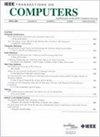新型 Sunway 超级计算机的 3500 万核上实现了具有 Ab Initio 精确度的 290 亿原子分子动力学模拟
IF 3.6
2区 计算机科学
Q2 COMPUTER SCIENCE, HARDWARE & ARCHITECTURE
引用次数: 0
摘要
断裂键和相变等物理现象需要从头算精度的分子动力学(MD),涉及数十亿个原子和超过纳秒的时间尺度。先前的最新研究表明,神经网络分子动力学(NNMD)如深势分子动力学(DeePMD),可以在ARM和GPU平台上以从头算的精度成功地扩展MD的时空尺度。然而,由于其独特的多核架构、内存层次结构和低精度能力,DeePMD-kit软件包目前无法充分利用新的神威超级计算机的计算潜力。在本文中,我们重新设计了DeePMD-kit,以利用新型神威的巨大计算能力,使MD拥有超过100亿个原子。我们首先设计了一个大规模并行方案来利用新神威的大规模并行性。然后,我们针对耗时的运算符设计了专门的优化。最后,利用新神威的低精度计算能力,为DeePMD-kit定制算子设计了一种新的混合精度方法。优化后的DeePMD-kit在新神威上实现了67.6 / 56.5美元的水/铜系统加速。同时,它可以在3500万个核(即9万个计算节点,约占整个超级计算机的84%)上对水系统进行290亿个原子模拟,峰值性能为57.1 PFLOPs,比最先进的结果大7.9美元,快1.2美元。这为研究更现实的场景铺平了道路,例如研究金属、半导体器件、电池和其他材料和物理系统的机械性能。本文章由计算机程序翻译,如有差异,请以英文原文为准。
29-Billion Atoms Molecular Dynamics Simulation With Ab Initio Accuracy on 35 Million Cores of New Sunway Supercomputer
Physical phenomena such as bond breaking and phase transitions require molecular dynamics (MD) with ab initio accuracy, involving up to billions of atoms and over nanosecond timescales. Previous state-of-the-art work has demonstrated that neural network molecular dynamics (NNMD) like deep potential molecular dynamics (DeePMD), can successfully extend the temporal and spatial scales of MD with ab initio accuracy on both ARM and GPU platforms. However, the DeePMD-kit package is currently unable to fully exploit the computational potential of the new Sunway supercomputer due to its unique many-core architecture, memory hierarchy, and low precision capability. In this paper, we re-design the DeePMD-kit to harness the massive computing power of the new Sunway, enabling the MD with over ten billion atoms. We first design a large-scale parallelization scheme to exploit the massive parallelism of the new Sunway. Then we devise specialized optimizations for the time-consuming operators. Finally, we design a novel mixed precision method for DeePMD-kit customized operators to leverage the low precision computing power of the new Sunway. The optimized DeePMD-kit achieves 67.6 / 56.5 $\boldsymbol{\times}$ $\boldsymbol{\times}$ $\boldsymbol{\times}$
求助全文
通过发布文献求助,成功后即可免费获取论文全文。
去求助
来源期刊

IEEE Transactions on Computers
工程技术-工程:电子与电气
CiteScore
6.60
自引率
5.40%
发文量
199
审稿时长
6.0 months
期刊介绍:
The IEEE Transactions on Computers is a monthly publication with a wide distribution to researchers, developers, technical managers, and educators in the computer field. It publishes papers on research in areas of current interest to the readers. These areas include, but are not limited to, the following: a) computer organizations and architectures; b) operating systems, software systems, and communication protocols; c) real-time systems and embedded systems; d) digital devices, computer components, and interconnection networks; e) specification, design, prototyping, and testing methods and tools; f) performance, fault tolerance, reliability, security, and testability; g) case studies and experimental and theoretical evaluations; and h) new and important applications and trends.
 求助内容:
求助内容: 应助结果提醒方式:
应助结果提醒方式:


